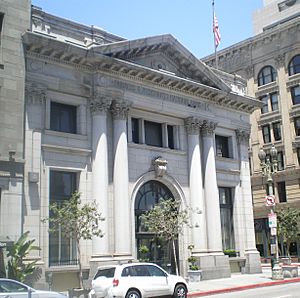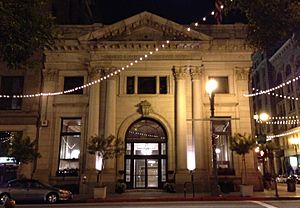Farmers and Merchants Bank of Los Angeles facts for kids
The Farmers and Merchants Bank (often called F&M) was an important bank in Downtown Los Angeles, California. It operated from 1871 to 1952. This bank is famous for its beautiful building and for playing a big part in the early growth of Los Angeles. You might find other banks named "F&M" in different cities, but they are not connected to this historic one.
Contents
History of the Bank
The Farmers and Merchants Bank started in 1871. Twenty-three important business people in Los Angeles created it. They began with a lot of money, about $500,000. Three of the biggest investors were Isaias W. Hellman, John G. Downey, and Ozro W. Childs. These three men later helped start the University of Southern California. Other early investors included Charles Ducommun and Jose Mascarel.
Starting the First Bank
This bank was the first official bank in Los Angeles. It was founded by Isaias W. Hellman, who was a successful merchant and banker. He moved to Los Angeles in 1859. He started the bank with John G. Downey, who was the seventh governor of California, and Herman W. Hellman, Isaias's brother. John G. Downey was the first president, but Isaias W. Hellman really ran the bank. Isaias was the bank's president from 1890 until he passed away in 1920.
Moving to New Buildings
The bank first opened in the Pico Building on Main Street. In 1874, the bank built new offices across the street. These were designed by architect Ezra F. Kysor. The bank moved again in 1883, to the corner of Main and Commercial streets.
A Careful Way of Banking
Isaias W. Hellman was very careful about who he lent money to. He made sure that people borrowing large amounts of money were trustworthy. They also had to offer good security, like valuable property. The bank's later presidents, J.A. Graves and Victor H. Rosetti, continued these careful ways. They kept a lot of the bank's money in safe government investments. Because of this, the bank survived many tough economic times. This included the Panic of 1873 and the Great Depression.
Joining with Other Banks
Over time, having only one bank location in downtown Los Angeles made it hard for the bank to grow. So, in 1956, the Farmers and Merchants Bank joined with Security First National Bank. This bank later became Security Pacific National Bank. Eventually, it was bought by the Bank of America.
Amazing Architecture
The Farmers and Merchants Bank building was finished in 1905. It was designed in the Classical Revival style. This means it looks a bit like ancient Roman temples. It is one of the best examples of these "temples of finance" that were popular around 1900.
Building Details
The front of the building has two stories. It has an entrance framed by tall, fancy Corinthian columns. These columns are topped by a large triangular shape called a pediment. The building was designed by the company Morgan and Walls.
What It's Like Today
The Farmers & Merchants Bank building is now a Los Angeles Historic-Cultural Monument. This means it's a very important historic place in Los Angeles. It is Monument #271.
Much of the original banking room inside is still there. You can see the old light fixtures and a big skylight in the middle of the ceiling. There's also a covered walkway called a loggia with old-fashioned railings. The building stopped being a bank in the late 1980s. Now, it is mostly used for special events, parties, and as a place to film movies. The building is planned to be updated by a developer named Tom Gilmore.




